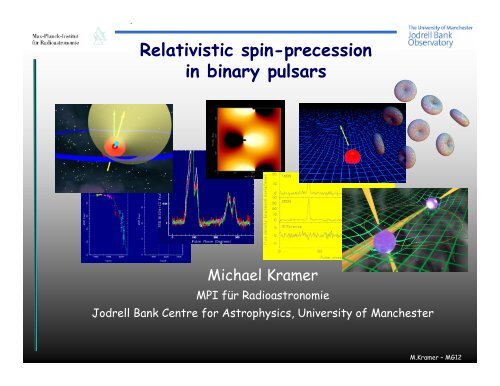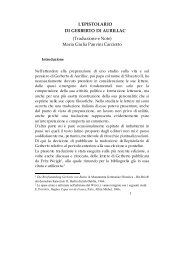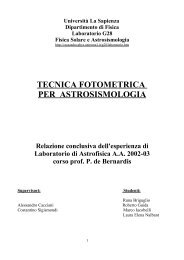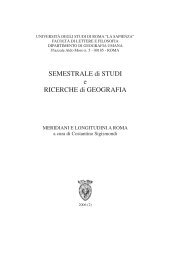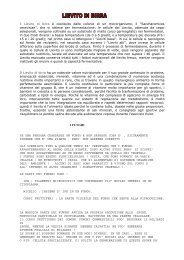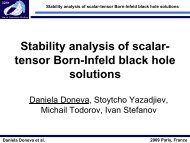B - ICRA
B - ICRA
B - ICRA
You also want an ePaper? Increase the reach of your titles
YUMPU automatically turns print PDFs into web optimized ePapers that Google loves.
Relativistic spin-precession<br />
in binary pulsars<br />
Michael Kramer<br />
MPI für Radioastronomie<br />
Jodrell Bank Centre for Astrophysics, University of Manchester<br />
M.Kramer – MG12
Outline<br />
• Introduction:<br />
Theoretical expectations<br />
Binary pulsars as labs for spin-precession<br />
• The experiments<br />
Observations, modelling, results<br />
• Applications<br />
GR and alternative theories<br />
Astrophysical uses<br />
• Summary & Conclusions<br />
M.Kramer – MG12
Theoretical expectations<br />
Due to the curvature of space-time the proper reference<br />
frame of a freely falling object suffers “geodetic precession”<br />
Experiments made in Solar System provide precise tests for this<br />
effect and confirm it, e.g.,<br />
- Lunar Laser Ranging<br />
- Gyro-experiments, i.e. Gravity-Probe B<br />
M.Kramer – MG12
Strong-field experiments<br />
We would like to have also a gyroscope or spinning top in the presence<br />
of strong gravitational fields…<br />
We would like to use a massive, spinning test mass where we can<br />
also infer and monitor the orientation of the spin direction<br />
⇒ use binary radio pulsars<br />
• In a binary pulsar system, geodetic precession leads to<br />
“relativistic spin-orbit coupling”<br />
• As a consequence, the pulsar spin precesses about the total angular<br />
momentum, changing the relative orientation of the pulsar<br />
M.Kramer – MG12
• …cosmic lighthouses<br />
• …almost Black Holes:<br />
Pulsars…<br />
mass of ~1.4 Solar Mass within 20km<br />
• …objects of extreme matter<br />
– 10x nuclear density<br />
– B ~ B cr = 4.4 x 10 13 Gauss<br />
– Voltage drops ~ 10 12 volts<br />
– F EM = 10 10-12 F gravity<br />
– High-temperature superfluid superconductor<br />
• …spinning with a wide range of periods:<br />
J1748-2446ad<br />
1.4 ms<br />
Period<br />
42,960 Rotations per Minute<br />
7<br />
J2144-3933<br />
8.5 s<br />
M.Kramer – MG12
Straw-man design of a pulsar<br />
• rotation induces<br />
electric quadrupole field<br />
• charges pulled out of<br />
surface, shielding force<br />
• plasma fills surrounding<br />
• co-rotation with pulsar<br />
• light cylinder: v=R L Ω=c<br />
• open and closed fieldlines<br />
• coherent emission,T b >10 31 K<br />
• MASER emission?<br />
Pulse shape determined by 2-D cut through non-uniform 3D beam:<br />
M.Kramer – MG12
Polarization: Signatures of Geometry<br />
• Geometry is important to understand pulsar properties<br />
• Pulsar emission is highly elliptically (mostly linearly) polarized<br />
• Circular component not understood<br />
• Linear component reflects B-field and geometry<br />
• “Rotating-Vector-Model”<br />
(Radhakrishnan & Cooke 1969)<br />
M.Kramer – MG12
The life of pulsars: death & rebirth<br />
Kramer & Stairs (2008)<br />
Dead pulsars with a<br />
companion can be spun-up<br />
(“recycled”) to become<br />
millisecond pulsars with<br />
WD companion or perhaps<br />
Double Neutron Stars<br />
NASA<br />
M.Kramer – MG12
Spin-Orbit coupling due to misaligned spins<br />
M.Kramer – MG12
Geodetic Precession<br />
• Relativistic Spin-Orbit Coupling<br />
expected<br />
• First prediction for observations<br />
by Damour & Ruffini (1974)<br />
• Precession rate expected in GR:<br />
(e.g. Barker & O’Connell ‘75, Börner et al. ‘75, Hari Dass & Radhakrishnan ‘75)<br />
5/<br />
3<br />
2π ⎞ 2 / 3 mc(<br />
4mp<br />
+ 3mc<br />
) 1<br />
−3<br />
⎟ T�<br />
, T = GM<br />
4 / 3 2 � �<br />
Pb 2(<br />
mp<br />
+ mc)<br />
1−<br />
e<br />
p ⎛<br />
Ω = ⎜<br />
c<br />
⎝ ⎠<br />
What effects do we expect to observe?<br />
M.Kramer – MG12
Geodetic Precession<br />
• Relativistic Spin-Orbit Coupling<br />
expected<br />
• First prediction for observations<br />
by Damour & Ruffini (1974)<br />
M.Kramer – MG12
Geodetic Precession<br />
• Relativistic Spin-Orbit Coupling<br />
expected<br />
• First prediction for observations<br />
by Damour & Ruffini (1974)<br />
Right ideas from the start:<br />
• Changing angles = changing pulsed radiation<br />
• Emission properties modulated with<br />
precession frequency<br />
M.Kramer – MG12
Effects of Geodetic Precession<br />
• Firstly, pulsar may not always be visible<br />
• Line-of-Sight will change<br />
• Changes in pulse shape, width and polarization<br />
M.Kramer – MG12
Effects of Geodetic Precession<br />
Cutting the beam at different precession phases:<br />
• Firstly, pulsar may not always be visible<br />
• Line-of-Sight will change<br />
• Changes in pulse shape, width and polarization<br />
M.Kramer – MG12
Observations and Experiments<br />
• For geodetic precession to be observed, we need binary system with<br />
misalignment between pulsar spin and total angular momentum vector<br />
• We require a system where last component was formed in an<br />
asymmetric supernova explosion<br />
P(ms) P b (d) x(lt-s) e Ω(º/yr)<br />
J0737-3039 22.7/2770 0.10 1.42/1.51 0.09 4.8/5.1<br />
B1534+12 37.9 0.42 3.73 0.27 0.5<br />
J1518+4904 40.9 8.64 20.0 0.25 -<br />
J1756-2251 28.5 0.32 2.76 0.18 0.76<br />
DNS J1753-2240 95.1 13.63 18.1 0.30 -<br />
J1811-1736 104.2 18.8 34.8 0.83 -<br />
J1829+2456 41.0 1.18 7.24 0.14 0.08<br />
J1906+0746 144.1 0.17 1.42 0.09 2.2 preecession<br />
B1913+16 59.0 0.33 2.34 0.62 1.2 =<br />
B2127+11C 30.5 0.34 2.52 0.68 1.9<br />
PSR-WD J1141-6545 394.0 0.20 ?? 0.17 1.4 Red observed<br />
M.Kramer – MG12
The first: PSR B1913+16<br />
Discovered by Hulse & Taylor in 1974<br />
M.Kramer – MG12
The pulse shape of PSR B1913+16<br />
First studies by Weisberg, Romani & Taylor (1989):<br />
Weisberg et al.’89<br />
No conclusive result:<br />
1981<br />
• Amplitude was changing slowly<br />
changing with time<br />
• Expected change in width was<br />
not detected!<br />
• \<br />
M.Kramer – MG12
The pulse shape of PSR B1913+16<br />
First studies by Weisberg, Romani & Taylor (1989):<br />
Kramer ‘98<br />
Weisberg et al.’89<br />
1995<br />
1981<br />
1.2%/yr<br />
M.Kramer – MG12
The pulse shape of PSR B1913+16<br />
First clear detection of geodetic precession (Kramer 1998):<br />
Kramer (1998, 2000, 2002,2003)<br />
Kramer (1998)<br />
• Profile found to become narrower with time<br />
• Prediction: pulsar will disappear in 2025!<br />
• Simple four parameter model incl misalignment angle: SN explosion<br />
• Derive beam map or make quantitative test…<br />
M.Kramer – MG12
The first results…<br />
Faith… Confirmation…<br />
M.Kramer – MG12
Beam mapping<br />
• Observations explained in simple bean model (Kramer 2000)<br />
• High-sensitivity Arecibo observations suggest some deviation<br />
(Weisberg & Taylor 2000, 2002; Clifton & Weisberg 2008):<br />
Kramer (2000)<br />
Basic idea: use slices through beam with time to reconstruct<br />
the previously unknown 3D image of pulsar beam!<br />
Clifton & Weisberg (2008)<br />
M.Kramer – MG12
The second case: B1534+12<br />
Smaller effect but first with polarization information<br />
(Stairs et al. 2000, 2004):<br />
• First time to measure changing geometry from polarization<br />
• Combination of aberration and precession effect detected<br />
• First attempt to derive quantitative test of precession rate<br />
M.Kramer – MG12
The second case: B1534+12<br />
Smaller effect but first with polarization information<br />
(Stairs et al. 2000, 2004):<br />
• First time to measure changing geometry from polarization<br />
• Combination of aberration and precession effect detected<br />
• First attempt to derive quantitative test of precession rate<br />
M.Kramer – MG12
The third: PSR J1141-6545<br />
• First non-DNS system: unusual system where young pulsar is in<br />
orbit with old heavy white dwarf<br />
• Relativistic 4.7-hr orbit, ideal for tests of alternative theories<br />
of gravity (see Verbiest’s talk in EG6 session on Thursday!)<br />
• Monitored by us since 2000, but also studied and first published<br />
by Hotan et al. (2005):<br />
Hotan et al. (2005)<br />
M.Kramer – MG12
The third: PSR J1141-6545<br />
• First non-DNS system: unusual system where young pulsar is in<br />
orbit with old heavy white dwarf<br />
• Relativistic 4.7-hr orbit, ideal for tests of alternative theories<br />
of gravity (see Verbiest’s talk in EG6 session on Thursday!)<br />
• Monitored by us since 2000, but also studied and first published<br />
by Hotan et al. (2005)<br />
• Rich behaviour in pulse shape, width and polarization (see<br />
Manchester et al. to be submitted):<br />
Manchester et al. (subm.)<br />
Manchester et al. (subm.)<br />
M.Kramer – MG12
The third: PSR J1141-6545<br />
• New modeling (see Kramer & Wex 2009) uses previously unused<br />
information about spin-axis provided by absolute position angle<br />
• Requires careful calibration and RM measurements<br />
(Manchester et al. to be submitted:)<br />
Position Angle (deg)<br />
Time<br />
Precession Phase<br />
Misalignment Angle<br />
M.Kramer – MG12
The third: PSR J1141-6545<br />
• New modeling (see Kramer & Wex 2009) uses previously unused<br />
information about spin-axis provided by absolute position angle<br />
• Requires careful calibration and RM measurements<br />
(Manchester et al. to be submitted:)<br />
• Self-consistent model that allows us to fit RVM to all epochs<br />
(i.e. 930 data points to just 4 parameters):<br />
Manchester et al. (subm.)<br />
• First mapping of unrecycled pulsar beam pattern!<br />
M.Kramer – MG12
The fourth: PSR J1906+0746<br />
• Second most relativistic pulsar (Lorimer et al. 2006)<br />
• Geodetic precession easily detected via interpulse component:<br />
Lorimer et al. (2005)<br />
• Unrivalled constraints from polarisation: excellent fit of<br />
4-param’s Kramer & Wex (2009) model: χ 2 =1.21 for 632 D.o.F. !<br />
Desvignes et al. (to be submitted)<br />
Desvignes et al. (2008)<br />
See talk by Gregory<br />
Desvignes in EG6 on<br />
Thursday!<br />
M.Kramer – MG12
The best: PSR J0737-3039<br />
PSR J0737-3039A/B discovered in April 2003:<br />
first and only system with two active pulsars<br />
Burgay et al. (2003), Lyne et al. (2004)<br />
J0737-3039<br />
McLaughlin et al. (2004)<br />
• A young 2.77-s pulsar in a 2.4-hr<br />
orbit with an old 22-ms pulsar.<br />
• Orbital velocities of 1 Million km/h!<br />
• Ideal lab for gravitational physics and<br />
understanding pulsars and neutron stars.<br />
M.Kramer – MG12
The Double Pulsar<br />
Five(!) unique strong-field tests, represented in a single mass-mass plot:<br />
Mass ratio & 6 PK parameters<br />
⇔7-2 = 5 tests of GR!<br />
Periastron<br />
advance<br />
More than in any system!<br />
Gravitational<br />
redshift<br />
s<br />
s<br />
exp<br />
obs<br />
Shapiro<br />
delay<br />
Best strong-field test<br />
= 1.<br />
0000 ± 0.<br />
0005<br />
Kramer et al (2006), Breton et al. (2008)<br />
Kramer et al. (2006)<br />
See Rob Ferdman’s talk<br />
in EG6 on Thursday<br />
and public talk in evening!<br />
Grav. wave emission<br />
Mass ratio<br />
(two orbits!)<br />
Shapiro<br />
delay<br />
Spin-orbit<br />
coupling<br />
M.Kramer – MG12
Geodetic Precession in J0737-3039A<br />
• Precession period of double pulsar only 71/74 years!<br />
A B<br />
Ferdman et al (2008)<br />
Manchester et al. (2005)<br />
Burgay et al. (2005)<br />
M.Kramer – MG12
Sin i=0.99987(-48.+13)<br />
A B<br />
McLaughlin et al. (2004)<br />
Eclipses of A<br />
To Earth<br />
20,000km<br />
Orbital phase →<br />
Peaks of emission not random!<br />
Separated by P and P/2 of B<br />
• Caused by synchrotron<br />
absorption of plasma trapped<br />
in B’s magnetosphere and<br />
heated by A’s wind: see<br />
Luytikov & Thompson (2005)<br />
← lasting for ~27 sec<br />
M.Kramer – MG12
Spin precession of B also seen in eclipse pattern:<br />
Breton et al. (2008):<br />
• Eclipse profile is changing<br />
with time<br />
• Pattern is changing due to<br />
relativistic spin precession<br />
M.Kramer – MG12
Relativistic Spin-Precession<br />
• We can both explain the eclipse pattern and measure the precession<br />
rate as a new test of general relativity (Breton et al 2008):<br />
See Rene Breton’s talk<br />
In EG6 on Thursday!<br />
• Measured with 13% precistion and in agreement with GR’s<br />
precession rate of 5.1 deg/yr<br />
• Also, first unique constraint on alternative theories due to<br />
measurement of theory-independent spin-precession parameter<br />
M.Kramer – MG12
Theory-independent constraints<br />
In a general class of theories, one can describe the SO-coupling<br />
with a Lagrangian (see Damour & Taylor 1992):<br />
Coupling function, different for different theories<br />
In this framework, we write a general (average) precession rate<br />
for pulsar B as:<br />
with<br />
Coupling constant<br />
Strong-field modified grav. constant<br />
M.Kramer – MG12
Theory-independent constraints<br />
We can rewrite precession rate in terms of observables:<br />
measured to be determined<br />
Note that both X A and X B are simultaneous<br />
measurable only in the Double Pulsar!<br />
M.Kramer – MG12
Theory-independent constraints<br />
We can rewrite precession rate in terms of observables:<br />
measured to be determined<br />
Note that both X A and X B are simultaneous<br />
measurable only in the Double Pulsar!<br />
We measure: whereas in GR:<br />
M.Kramer – MG12
In other words, we have for the first time a measurement of the<br />
coupling constant!<br />
With<br />
Theory-independent constraints<br />
whereas in GR we expect a value of 2.<br />
� This is the first time that we have a measurement of this strongfield<br />
parameter. All theories of gravity must predict this value.<br />
Unique Unique test test of of effacement effacement property property of of spinning spinning body! body!<br />
M.Kramer – MG12
Applications of spin-orbit coupling<br />
• Tests of theories of gravity<br />
• Beam mapping and emission physics<br />
• Core collapse supernovae and kick mechanisms:<br />
- first such application by Wex et al. (2000) for PSR B1913+16:<br />
- From geodetic precision<br />
derive geometry<br />
- Compute back in time<br />
until last supernova<br />
- Use conservation laws<br />
(momentum etc.) to<br />
constrain pre-supernova<br />
system e.g. derive kick<br />
amplitude and direction<br />
Kick velocity<br />
Polar angle of kick<br />
M.Kramer – MG12
PDF<br />
Applications of spin-orbit coupling<br />
• Tests of theories of gravity<br />
• Beam mapping and emission physics<br />
• Core collapse supernovae and kick mechanisms:<br />
- first such application by Wex et al. (2000) for PSR B1913+16<br />
- see large amount of work by Kalogera group, e.g. Willems et al. ’04<br />
- or our work on PSR J0737-3039B by Stairs et al. (2006)<br />
Stairs et al. (2006)<br />
J0737-3039<br />
B1534+12<br />
J0737-3039<br />
B1534+12<br />
⇒ Progenitor of B was light: 1.37-1.80 M � (95%)!<br />
⇒ Different formation process? WD collapse?<br />
J0737-3039<br />
B1534+12<br />
M.Kramer – MG12
Applications of spin-orbit coupling<br />
• Tests of theories of gravity<br />
• Beam mapping and emission physics<br />
• Core collapse supernovae and kick mechanisms:<br />
- first such application by Wex et al. (2000) for PSR B1913+16<br />
- see large amount of work by Kalogera group, e.g. Willems et al. ’04<br />
- or our work on PSR J0737-3039B by Stairs et al. (2006)<br />
• Moment-of-inertia measurement and EoS:<br />
Total periastron advance at 2PN level: Damour & Schaefer (1988)<br />
3β<br />
tot<br />
k<br />
2<br />
0 =<br />
1−<br />
eT<br />
1 0 0 S 0 S S 0β<br />
S<br />
[ ]<br />
2 A A B B<br />
+ f β − g β β − g β<br />
1PN 2PN Spin A Spin B<br />
2πc<br />
1<br />
β =<br />
G P<br />
Neutron star dependent S<br />
2<br />
p<br />
I<br />
m<br />
Lattimer & Schutz (2005)<br />
See Kramer & Wex ‘09<br />
M.Kramer – MG12
Summary & Conclusions<br />
• After first detection in PSR B1913+16, spin-orbit coupling has<br />
been observed, modelled and used in a number of binary pulsars<br />
• We observe all predicted effects like changes in pulse width,<br />
shape, polarisation and overall visibility<br />
• Finally, we are also doing quantitative tests with a first<br />
confirmation of the effacement property of spinning bodies in<br />
strong gravitational fields<br />
• Besides tests of gravitational theories, we have a new tools for<br />
astrophysics to study pulsar beams, the core collapse of massive<br />
stars, the formation of neutron stars and eventually the<br />
measurement of NS moment of inertia with constraints for the<br />
Equation-of-State.<br />
M.Kramer – MG12


